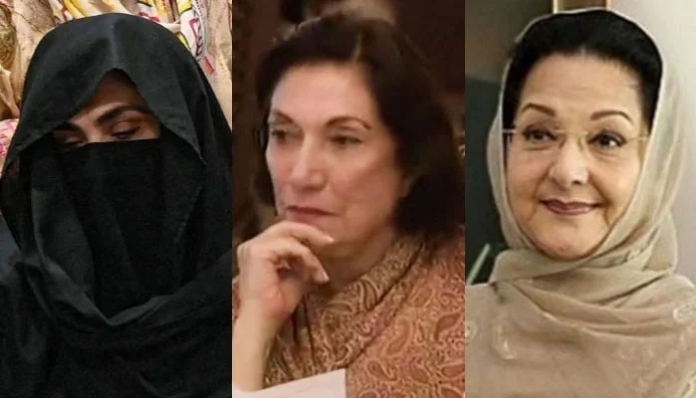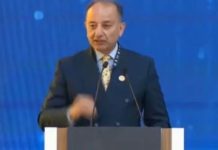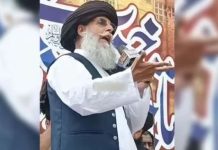LAHORE, DEC 2 (DNA): Bushra Bibi, the third former first lady after Begum Nusrat Bhutto and Begum Kulsoom Nawaz, is leading the movement for the release of her husband, Pakistan Tehreek-e-Insaf (PTI) founder-chairman Imran Khan, who is in detention like other two former prime ministers, Zulfikar Ali Bhutto and Nawaz Sharif.
However, the most striking question that comes to the mind of people who are witnesses to the history is whether Bushra Bibi will be able to match the struggle of those two former first ladies of Pakistan, of which one was unable to save her husband from execution in 1979, while the other successfully got her husband out of detention through a pardon deal in 2000.
Moreover, what are the similarities and differences between the movements led by Nusrat, Kulsoom and the wife of Khan, that also raised several questions about the future of the movement led by Bushra Bibi.
Bushra, the former wife of a bureaucrat Khawar Maneka married the cricketer-turned-politician, after her divorce from Khawar in the year 2018. It was the same year when Khan became the prime minister after a 22-year-long struggle and his party and allies formed government in the centre, Punjab, KP and Balochistan.
In the year 2022, Khan had to lose the Prime Minister’s Office due to a no-confidence move and almost at the same period of time, his terms with the country’s establishment, which had been quite cordial since 2011 severed.
After dissolving his own government in Punjab, while pressing his ally Chaudhry Pervaiz Elahi, the-then chief minister, Khan’s real test started. In the month of May 2023, the notorious episode related to an attack on Corps Commander’s House in Lahore occurred on May 9 after the deposed premier’s arrest and things started to severe for him and his party.
In the later period, Khan and Bushra both had to face conviction at the hands of the court in cases like Toshakhana and iddat case.
However, Bushra Bibi received bail earlier this year and was able to look into the party affairs. After her release, she led the recent November 24 call of PTI, the first protest or movement for her, in which party leadership from Khyber Pakhtunkhwa also got seriously criticised by the workers battling against state institutions on roads.
In this movement, Bushra, KP CM Ali Amin Gandapur, party top brass like Omar Ayub, Salman Akram Raja and others were under fire from the charged workers of the PTI from KP, who also engaged in clashes with the security personnel at D Chowk, Islamabad.
In simple words, the motive behind the movement or call was not achieved, which instead turned the PTI workers against the former first lady, Gandapur and senior party leaders for remaining confined to the container and enjoying the state protocol of the KP government.
Interestingly, Khan’s own sister was amongst the PTI workers at a time while Bushra was on the container. This is pertinent to mention that at a time while Bushra is leading the movement, the PTI enjoys a full-fledged government in one province of the country — Khyber Pakhtunkhwa.
There, the former first lady seems to be enjoying full protocol and security, which was never the case with Begum Nusrat or Begum Kulsoom, after their husbands were under detention by former presidents, General Ziaul Haq and General Pervez Musharraf, respectively.
After the imposition of July 5, 1977, martial law, all five elected governments, including one of the Centre and four related to the provinces were dismissed.
The PPP founder and the first elected prime minister, Zulfikar, was under arrest in the coming days and while he spent his last 323 days in imprisonment since April 1979, the party was being led by Begum Nusrat. She, along with her daughter Benazir Bhutto actively mobilised the party and combated against a powerful government.
After April 4, 1979, when Zulfikar was executed, Begum Nusrat led the PPP constantly till 1984 and later till the 1988 general elections. During that period of time, she had to face torture at the hands of police, disloyalty in the hands of some former party men who ditched PPP and worst of all was the tragic news related to the death of her son Shahnawaz while her elder son Murtaza was in exile.
Tragically, three of Nusrat’s children, including her two sons and eldest daughter Benazir died in her life. Shahnawaz’s death occurred abroad while the former first lady was leading the PPP during the dictatorial regime.
During the 11 years from 1977 to 1988, Nusrat enjoyed no state protocol during any movement for the restoration of democracy.
Whereas, Kulsoom had to unexpectedly lead her party after the October 12, 1999 incident while the sitting chief of army staff Gen Pervez Musharraf took over.
The-then prime minister, Nawaz, and his brother, Shehbaz Sharif — who was the chief minister of Punjab at that time — were under arrest after the October 12, 1999 coup.
A few months later, Nawaz was convicted by the court for 21 years and it was Begum Kulsoom, who started the movement to save the Pakistan Muslim League-Nawaz (PML-N) from splitting.
Key figures who sided with the party at that time included Makhdum Javed Hashmi, Pervaiz Rasheed, Mushahid Ullah Khan, Zaeem Qadri, Khawaja Saad Rafique, Sardar Zulfiqar Ali Khan Khosa.
Kulsoom and PML-N workers also had clashes with the then-administration on roads and an episode in which she locked her car for hours while clashing with the police went on.
By the last quarter of the year 2000, Nawaz along with his family left for Jeddah after signing a deal with Musharraf due to the lobbying of Saudi Arabia.
During the period while Kulsoom led the party and movement for the release of Nawaz, the PML-N had no government in any province of the country and the party was in direct confrontation with the Musharraf-led regime and massive arrest of PML-N workers also remained underway.
This is also pertinent to mention that Begum Nusrat and Begum Kulsoom were never convicted by the court during their struggle and interestingly, also had no corruption charges attributed to them as the former first ladies.

















